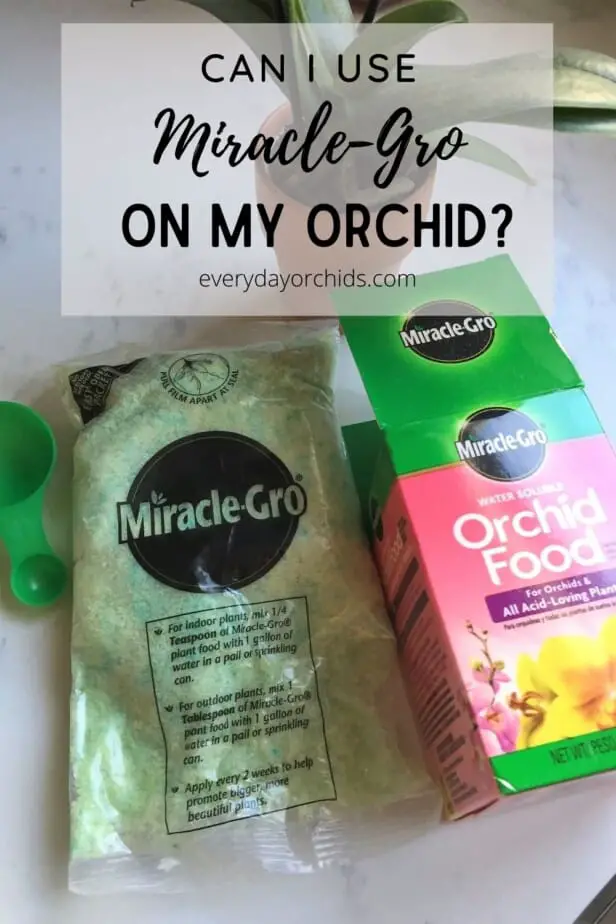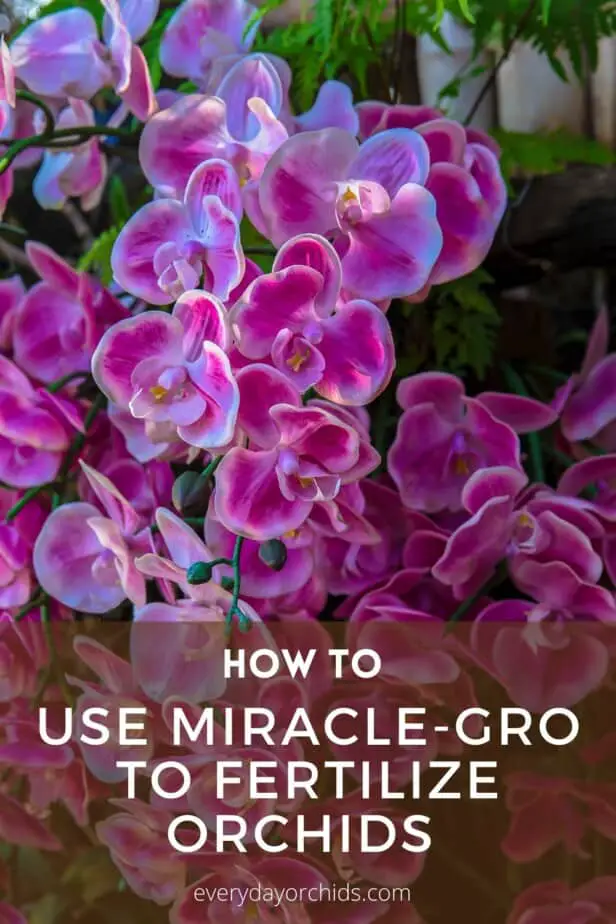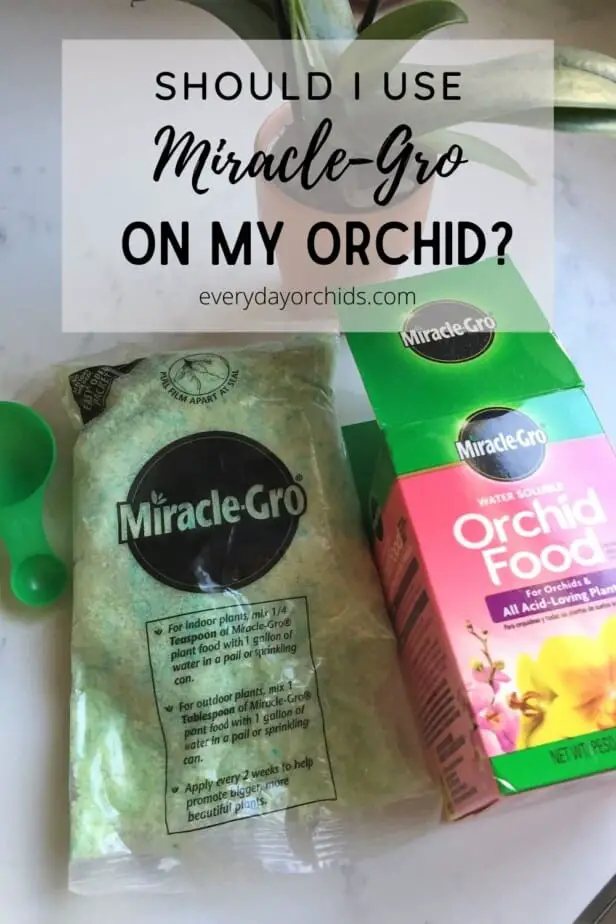Are you wondering if you can use Miracle Gro fertilizer on your orchids? Many people love using Miracle Gro fertilizer on their plants because it is easy to use and easy to find. It is a familiar brand and reasonably priced. Many garden centers and hardware stores carry Miracle Gro products. But this doesn’t necessarily mean it is safe to use Miracle Gro on your orchids. Keep reading to find out more.
Yes, you can use Miracle Gro fertilizer on your orchids, but with one catch. You will need to choose an orchid specific product, such as Miracle Gro Water Soluble Orchid food. This particular fertilizer has a NPK, or nitrogen-phosphorus-potassium, ratio of 30-10-10. This ratio will work well for most orchid varieties. You will find the best results when you fertilize your orchids “weekly, weakly” with a diluted orchid-specific fertilizer.
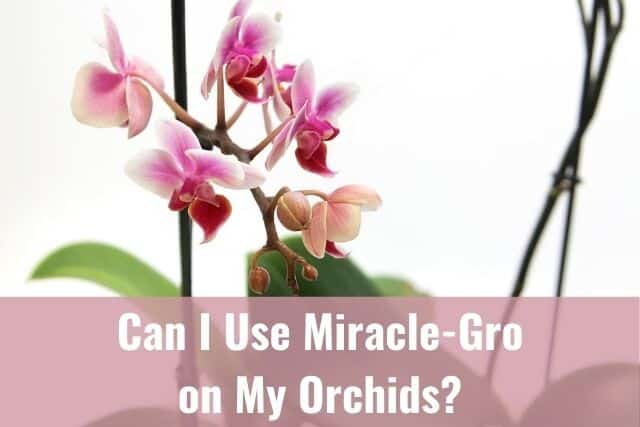
In this article, I’ll discuss the pros and cons of using Miracle Gro fertilizer on your orchids. I’ll explain why an orchid-specific NPK ratio is important when selecting a fertilizer for your orchids. There are other uses for your orchid fertilizer as well, and I’ll share those with you here.
Please note that these links are affiliate links and as an Amazon Associate, I earn from qualifying purchases. Purchases made through affiliate links in this post may generate commissions at no additional cost to you. Use this link for a discounted Amazon Prime trial. Thank you for your support!
Table of Contents
Can I Use Regular Miracle Gro On My Orchids?
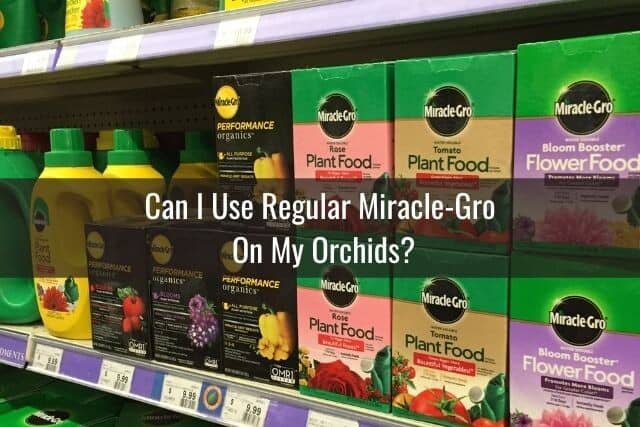
You may be asking this because you already have the all-purpose Miracle Gro fertilizer at home. Perhaps you are already using it for your other plants in your garden. Instead of buying a separate fertilizer for your orchids, you want to use this for your orchids too. But the question is, should you use the all-purpose Miracle Gro on your orchids?
The short answer is no. It is best to use an orchid specific fertilizer for your orchids. Miracle Gro makes a fertilizer for orchids, which is called Miracle Gro Water Soluble Orchid Food. While it may be tempting to use the regular all-purpose Miracle Gro, the orchid specific version has a NPK ratio tailored to your orchid’s needs, so be sure you buy this instead.
What is the NPK Ratio?
NPK stands for nitrogen, phosphorus, and potassium. Nitrogen promotes leaf growth in orchids. Phosphorus is important in root growth and forming new orchid blooms. Potassium helps with overall growth and allows your orchid to thrive. The orchid specific Miracle Gro product has an NPK ratio of 30-10-10. This translates into 30% nitrogen, 10% phosphorus, and 10% potassium. A 30-10-10 NPK ratio is what many orchids need.
The all-purpose Miracle Gro, however, is made for use on flowers, vegetables, shrubs, trees, and houseplants. It has a NPK ratio of 24-8-16, meaning 24% nitrogen, 8% phosphorus, and 16% potassium. As you can see, the all-purpose Miracle Gro has less nitrogen and phosphorus than what your orchid needs. Leaf and root growth may be less noticeable. Your orchid blooms may not be as large or plentiful as they might be with an orchid-specific fertilizer.
How Do You Use Miracle Gro on Your Orchids?
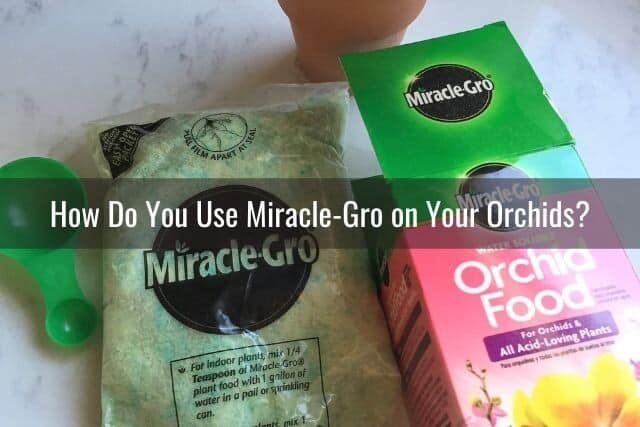
The Miracle Gro Water Soluble Orchid food is made specifically for orchids and acid-loving plants. You can use this on both your indoor and outdoor orchids.
How to Prepare the Fertilizer
For indoor orchids, Miracle Gro recommends mixing 1/4 teaspoon of orchid food in 1 gallon of water. Use this mixture to fertilize your orchids once every two weeks during the growing season. Fertilize just once a month during the orchid’s rest period.
For outdoor orchids, such as terrestrial orchids, the recommendation is to mix 1 tablespoon of orchid food in 1 gallon of water. Apply this fertilizer mixture to the soil around the orchids when you water your orchids.
How Often to Fertilize
Many orchid growers follow the “weekly, weakly,” rule of thumb. This means they fertilize their orchids each week using a diluted, “weak” fertilizer mixture. To make a “weak” fertilizer mixture, you can use 1/8 teaspoon of orchid food in 1 gallon of water. You can adjust the measurements up or down incrementally until you find the concentration that works best for your orchids. Be mindful not to make it stronger than 1/4 teaspoon orchid food mixed in 1 gallon of water.
When preparing to fertilize your orchids, first water your orchids thoroughly with plain water. Then apply the fertilizer mixture to the roots. Do not apply fertilizer directly to dry orchid roots. This might cause root burn and damage your orchid’s roots.
It is a good idea to skip a feeding once a month or so and just water your orchids with plain water. Doing so will allow the water to flush out any residual salts that may have built up from fertilizing.
I go into more detail about how to fertilize your orchids in another article, if you are interested in learning more.
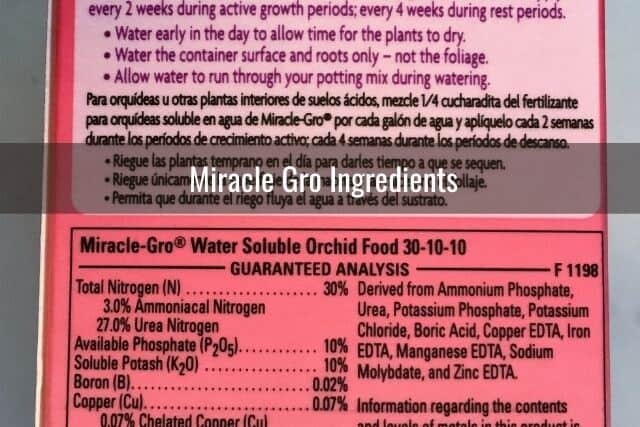
How Do You Use Miracle Gro Food Mist?
Another Miracle Gro fertilizer made specifically for orchids is the Miracle Gro Plant Food Mist. This product claims to feed your orchids instantly. After watering your orchid, spray the food mist onto the leaves, roots and growing media. Avoid spraying the flowers. You can use this product once a week to feed your orchids.
There is a white toggle button on the neck of the spray bottle which works similar to an “on/off” switch. If you have bought this product and cannot seem to get it to work, check to see if the white toggle needs to be switched “on.”
The NPK ratio for the Miracle Gro orchid food mist is 0.02-0.02-0.02. Remember, this is already diluted and ready for use. This is why the numbers for the NPK ratio seem so low.
It also makes the product fairly expensive from a value point of view. Most of the product is made of water with a bit of fertilizer concentrate mixed in. Theoretically, you could buy the concentrated version of an orchid fertilize and dilute it in water yourself. You could put it in a spray bottle with a mist feature, and use this on your orchids. This would stretch your dollar further while achieving nearly the same results.
How Do You Use Miracle Gro Orchid Food Sticks?
According to Miracle Gro, you will need to cut these orchid food sticks in half. Place these into the orchid potting mix, distributing the pieces evenly between the plant and the edge of the pot. Be sure to wash your hands after handling these fertilizer sticks.
These are slow-release fertilizer sticks. Each time you water your orchid, these spikes will dissolve a little, releasing nutrients and food to your orchid. Like other fertilizers, the recommendation is to use these during the orchid’s growth period. Replace the food sticks once every two months.
The NPK ratio of the Miracle Gro orchid food sticks is 10-10-10. This contains less nitrogen than what orchids need. The benefit to using these is that you do not have to prepare a fertilizer solution using water and a concentrate.
Another benefit is that you only need to replace these once every couple of months. For busy orchid growers, this aspect is beneficial. However, some orchid growers have reported not seeing any results with these.
What is a Drawback to Using Miracle Gro on Orchids?

There are some people that swear by Miracle Gro and use it to fertilize all their orchids. They boast of beautiful blooms and healthy looking plants. There are others who hate it and would not use it on their orchids. The presence of urea is one major reason why some people dislike using Miracle Gro on their orchids.
Urea in Miracle Gro
Unfortunately, Miracle Gro fertilizer contains urea. Typically, you want to avoid urea when buying a fertilizer for your orchids. However, many high nitrogen fertilizers may contain some urea.
Urea can be problematic for epiphyte orchids. Usually, soil organisms help convert the urea nitrogen into a form of nitrogen that can be easily absorbed by plants. This would be fine for terrestrial orchids.
However, since many orchids are not grown in soil, they lack the soil organisms needed to convert urea nitrogen to a usable form. Epiphyte orchid plants cannot efficiently perform this urea nitrogen conversion. As a result, they are unable to get all the nitrogen available from the fertilizer.
The all-purpose Miracle Gro contains 24% total nitrogen. This is further broken down into 3.5% ammonium nitrogen and 20.5% urea nitrogen. The orchid specific Miracle Gro contains 30% total nitrogen. This consists of 3% ammonium nitrogen and 27% urea nitrogen.
Ammonium nitrogen is a form of nitrogen that is immediately available for uptake and absorption by the orchid roots. Urea nitrogen is not.
Urea nitrogen is present in significant proportions in both of these Miracle Gro products, even the one that is designed specifically for orchids. Though this product boasts an NPK ratio of 30-10-10, keep in mind that your orchid likely will not be able to get all the nitrogen from the fertilizer.
Choose a Urea Free Orchid Fertilizer

Instead, choose a fertilizer that has its nitrogen in the ammonia nitrogen or nitrate nitrogen form. Orchids can more easily absorb ammonia nitrogen or nitrate nitrogen.
Most garden centers carry at least one brand of orchid fertilizer that is urea free. It may be more expensive than the ubiquitous Miracle Gro. However, the urea free nature of the fertilizer will allow your orchid to absorb more nitrogen from each feeding. The urea free fertilizer pictured above is the Grow More Premium Orchid Food. This is highly rated and one of the more popular urea free fertilizers out there.
What Other Plants Can You Use Orchid Fertilizer On?
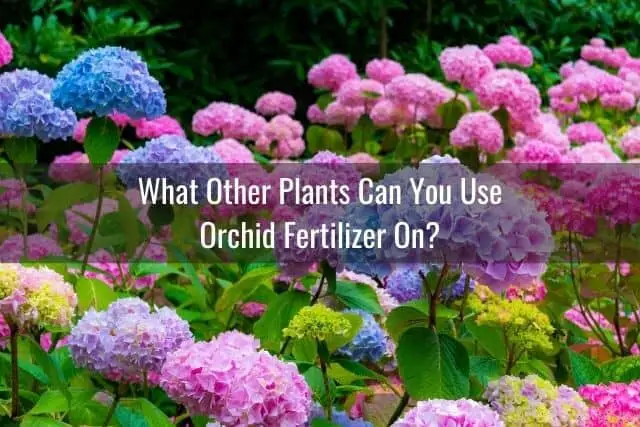
If you have leftover diluted orchid fertilizer, you can save it for your next orchid feeding. You can also use it on certain other plants in your garden. According to the product description, orchid-specific Miracle Gro fertilizer is ideal for orchids and other acid-loving plants. The question is, what qualifies as an acid-loving plant?
Acid-loving plants prefer a soil pH of 5.5. If you are not sure what your soil pH is, you can use a soil test kit to find out. Some examples of acid-loving shrubs are azaleas, rhododendrons, holly plants, and gardenias. Flowering plants that prefer acidic soil include the Japanese iris, begonia, and caladium plants. Dogwood, beech, willow oak, hibiscus and magnolia trees are some examples of trees that prefer a low, or acidic, soil pH.
Using Leftover Orchid Fertilizer on Hydrangea Plants
Hydrangea plants can also tell you about your soil pH. If the soil pH is below 6, the soil is acidic. The blooms on the hydrangea bush will be a blue color. A high (basic) soil pH is above 7. With a basic soil pH, the hydrangea blooms will appear pink or red. If the soil pH is neutral, with a pH between 6 and 7, the hydrangea blooms will be lavender or purple.
You can feed your hydrangea bush with leftover orchid fertilizer if you want to encourage more blue or purple blooms on your hydrangea plant. I often do this, actually. Of course, this is assuming the soil is already acidic and you have blue hydrangea blooms. Sprinkling coffee grounds or grass clippings around the hydrangea plant will help make the soil more acidic.
Conversely, you can use wood ash or lime around your hydrangea plant to increase the soil pH and make it more basic. You can also use a fertilizer with more phosphorus to make the soil more alkaline. This will encourage pink blooms on your hydrangea bush.
Final Thoughts
Choosing the right fertilizer for your orchid plants can be daunting. You may be tempted to just grab any old Miracle Gro product, since you see it being sold everywhere. However, if you are going to use Miracle Gro, be sure you choose one that is specially made for orchids.
Look for an NPK ratio of 30-10-10. Follow the recommendations for mixing and diluting your orchid fertilizer. If you plan to fertilize your orchids each week, further dilute your mixture with water. This way you do not accidentally over fertilize your orchids.
If you enjoyed this article, please pin it and share!
